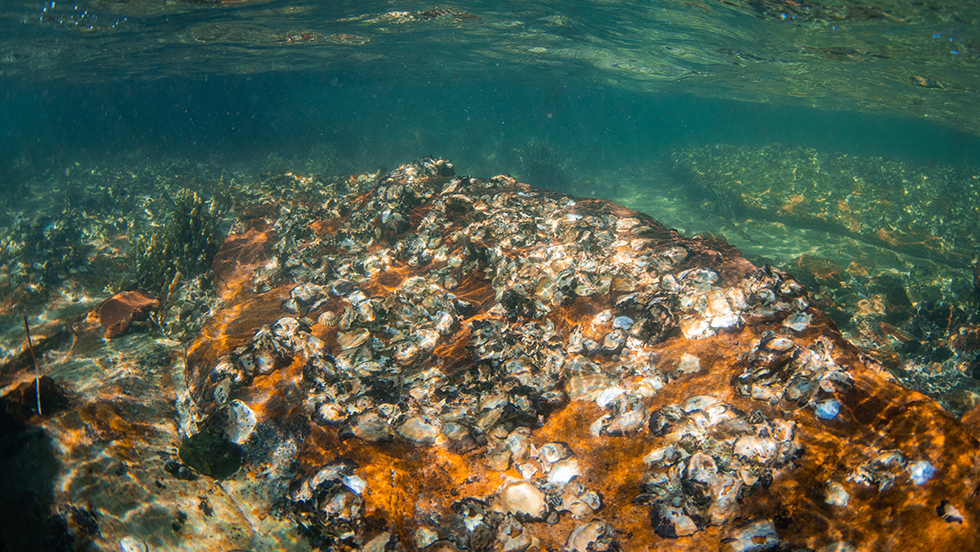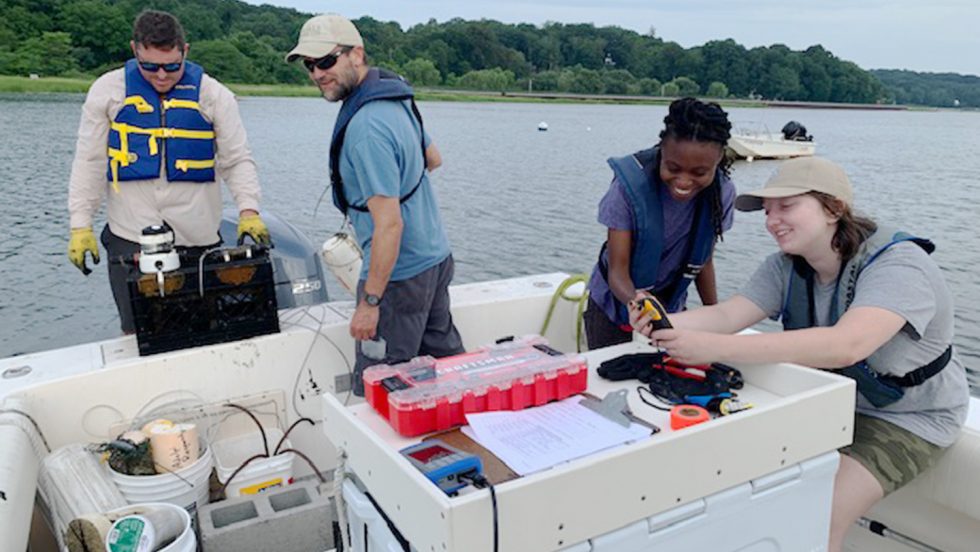
Adelphi scientists work to restore biodiversity to local coastlines.
Over the past century, human activity has brought devastation to the once-flourishing ecosystems of Long Island Sound. As recently as the 1980s, kelp populations grew abundantly along the shores, but all kelp forests have since vanished, likely due to rising water temperatures. Now, where kelp used to grow, harmful algae bloom, often choking out other life. Clam and oyster populations have also been hit hard, hurting both the local ecology and those who depended on shellfish to make a living.
Since 2012, however, two Adelphi scientists have been working hard to turn the tide of destruction. Ryan Wallace, PhD, assistant professor of environmental studies and sciences, and Aaren Freeman, PhD, professor and acting chair of biology, have teamed up to help preserve what remains of Long Island Sound’s ecosystems—and even restore some of its former biodiversity.
Dr. Wallace began by focusing his efforts on the depleted bivalve populations of Shinnecock Bay, which had suffered a 95 percent reduction in harvest. “Bivalves like oysters and clams are what are known as ‘keystone species’ because they provide many ecological services,” he said. “They’re filter feeders, actively pumping water into their bodies and sorting particles out to feed on. The more bivalves you have, the fewer harmful algal blooms you have.”
To rebuild the populations, Dr. Wallace, as part of a multi-institutional research team, acquired more than 3 million hard clams, a popular species among fishermen, and stocked them in “spawner sanctuaries”-—no-harvest zones created in collaboration with the local community in Shinnecock Bay. There, the creatures were free to grow to maturity without threat of harvesting. “Thanks to their presence, we saw an improvement in water quality and seagrass abundance, a decrease in brown tide blooms and, surprisingly, an increase in the commercial harvest in other areas of the bay,” Dr. Wallace said. He and his team published their work in “Rebuilding a Collapsed Bivalve Population, Restoring Seagrass Meadows, and Eradicating Harmful Algal Blooms in a Temperate Lagoon Using Spawner Sanctuaries” (Frontiers in Marine Science, August 2022), finding that spawner sanctuaries “may be promising for recovering hard clam and other bivalve populations in estuaries around the globe.”1

Ryan Wallace, PhD (left) and Aaren Freeman, PhD (in baseball cap), at work off the coast of Long Island.
At the same time, Dr. Freeman sought to address the root of this ecological chain reaction by preventing nutrient pollution itself. “One of the main problems contributing to ecological damage is the use of industrial fertilizers on land in the form of nitrates or ammonia,” he explained. “When people use these fertilizers on crops or grass, the excess nitrogen flows into the sea, leading to what’s known as eutrophication, or the excessive accumulation of a nutrient in the water that can throw an ecosystem out of balance.”
Dr. Freeman has spent the past several years exploring an organic alternative to industrial fertilizers: kelp, which does not require fresh water and can be grown even in the winter. With assistance from a National Fish and Wildlife Foundation (NFWF) grant, he and his team planted kelp at multiple sites along Long Island Sound, then provided the kelp to local towns, which spread the harvested crops on golf course fairways in place of industrial fertilizer. “Normally, the kelp would degrade and the nitrogen would go back into the ecosystem, but by removing it and putting it on the golf course, it basically closes the nitrogen loop,” Dr. Freeman said. If the project continues to yield improvements in water quality, Nassau County officials plan to implement the same treatment regimen for town parks.
The NFWF is also funding another project co-led by Drs. Wallace and Freeman, which draws on lessons learned from their prior successes. By monitoring the evolution of oyster larvae in an existing spawning sanctuary, they aim to collect enough data to identify the best potential sites for other sanctuaries along the coast. The team will also track water quality data to generate hydrodynamic and habitat suitability models for future sanctuaries—the first time this kind of modeling has been applied to the Oyster Bay area.
While the project’s outlook is auspicious, Dr. Freeman is hesitant to promise any magic bullets for a decimated ecosystem. “We still need to drastically reduce nitrogen pollution, even with all the kelp we’re growing and the oysters we’re raising,” he said. “All the same, I’m very hopeful that some of these efforts will have a positive impact on restoring these local habitats.”
1 Wallace, Ryan B., et al. “Rebuilding A Collapsed Bivalve Population, Restoring Seagrass Meadows, and Eradicating Harmful Algal Blooms in a Temperate Lagoon Using Spawner Sanctuaries.” Frontiers in Marine Science, vol. 9, August 2022, p. 30.